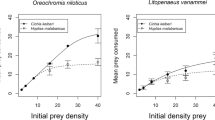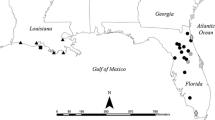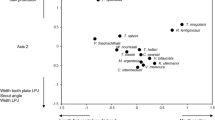Synopsis
One of the major goals of an ecomorphological analysis is to correlate patterns of interspecific differences in morphology with patterns of interspecific differences in ecology. Information derived from functional morphological studies may provide a mechanistic framework supporting the correlation, but the move from a correlational relationship to a causal relationship requires experimental evidence that the interspecific morphological differences create performance differences and therefore ecological differences. The goal of this study was to examine ecomorphological relationships in the diets of cottid fishes (Scorpaeniformes: Cottidae) from the northeastern Pacific by using functional classifications of predators (based on their mode of attack) and of prey (based on their anti-predator defenses). The proposed ecomorphological relationships were tested by examining capture success among the cottids in attacks on prey with different escape abilities. As predicted on functional morphological grounds, both multivariate and univariate analyses indicated that the gravimetric importance of ‘elusive prey’ (i.e. fishes, shrimp, mysids, and octopods) was greater in cottid species with a larger relative mouth size. Supporting a causal link between morphology and ecology, performance tests indicated that larger-mouthed cottids had significantly higher capture success on Heptacarpus shrimp than did smaller-mouthed species. As predicted, there were no differences in capture success among predators regardless of their attack style or ecomorphological patterns in attack on crabs (Cancer and Petrolisthes spp.) when the crabs were presented on a sand surface (i.e. ‘easy prey’). Several difficulties still exist when trying to apply a functional group approach to ecomorphology. These include the behavioral plasticity of the predators, the confounding factor of evolutionary history in identifying correlated ecomorphological features, multiple morphological solutions to common functional problems, the limitations of traditional dietary studies during extremes of prey abundance, and an inadequate understanding of the anti- predator defenses of most prey, including modifications that occur during ontogeny or in different habitats.
Similar content being viewed by others
References cited
Alexander, R.McN. 1967. The functions and mechanisms of the protrusible upper jaws of some acanthopterygian fish. J. Zool. Lond. 151: 43–64.
Alexander, R.McN. 1970. Mechanics of the feeding action of various teleost fishes. J. Zool. Lond. 162: 145–156.
Barel, C.D.N. 1983. Towards a constructional morphology of cichlid fishes (Teleostei, Perciformes). Neth. J. Zool. 33: 357–424.
Bentzen, P. & J.D. McPhail. 1984. Ecology and evolution of sympatric sticklebacks (Gasterosteus): specialization for alternative trophic niches in the Enos Lake species pair. Can. J. Zool. 62: 2280–2286.
Casinos, A. 1978. The comparative feeding mechanisms of Gadidae and Macrouridae. Gegenbaurs morphologisches Jahrbuch 124: 434–449.
Chadwick, E.M. 1976. A comparison of growth and abundance for tidal pool fishes in California and British Columbia. J. Fish Biol. 8: 27–34.
Chao, L.N. & J.A. Musick. 1977. Life history, feeding habits, and functional morphology of juvenile sciaenid fishes in the York River Estuary, Virginia. U.S. Fish. Bull. 75: 657–702.
Cooper, S.D., D.W. Smith & J.R. Bence. 1985. Prey selection by freshwater predators with different foraging strategies. Can. J. Fish. Aquat. Sci. 42: 1720–1732.
Coughlin, D.J. & J.R. Strickler. 1990. Zooplankton capture by a coral reef fish: an adaptive response to evasive prey. Env. Biol. Fish. 29: 35–42.
Cross, J.N. 1981. Structure of a rocky intertidal fish assemblage. Ph.D. Thesis, University of Washington, Seattle, 258 pp.
Daniel, T.L. & E. Meyerhofer. 1989. Size limits in escape locomotion of carridean shrimp. J. Exp. Biol. 143: 245–265.
Davis, W.P. & R.S. Birdsong. 1973. Coral reef fishes which forage in the water column. Helgol. Wiss. Meerunters. 24: 292–306.
de Groot, S.J. 1969. Digestive system and sensorial factors in relation to the feeding behavior of flatfishes (Pleuronectiformes). J. Const. int. Explor. Mer. 32: 385–395.
De Martini, E.E. 1969. A correlative study of the ecology and comparative feeding mechanism morphology of the Embiotocidae (surf-fishes) as evidence of the family's adaptive radiation into available ecological niches. Wasmann Journal of Biology 27: 177–245.
Demetropoulos, C.L., L.F. Braithwaite, B.A. Maurer & D. Whiting. 1990. Foraging and dietary strategies of two sublittoral cottids, Jordania zonope and Artedius harringtoni. J. Fish Biol. 37: 19–32.
De Silva, S.S., P.R.T. Cumaranatunga & C.D. De Silva. 1980. Food, feeding ecology and morphological features associated with feeding of four co-occurring cyprinids (Pisces: Cyprinidae). Neth. J. Zool. 30: 54–73.
Douglas, M.E. & W.J. Matthews. 1992. Does morphology predict ecology? Hypothesis testing within a freshwater stream fish assemblage. Oikos 65: 231–224.
Drenner, R.W., J.R. Strickler & W.J. O'Brien. 1978. Capture probability: the role of zooplankter escape in the selective feeding of planktivorous fish. J. Fish. Res. Board Can. 35: 1370–1373.
Drost, M.R., J.W.M. Osse & M. Muller. 1988. Prey capture by fish larvae, water flow patterns and the effect of escape movement of prey. Neth. J. Zool. 38: 23–45.
Ebeling, A.W. & G.M. Cailliet. 1974. Mouth size and predator strategy in midwater fishes Deep-Sea Research 21: 959–968.
Elshoud-Oldenhave, M.J.W. & J. Osse. 1976. Functional morphology of the feeding system of the ruff — Gymnocephalus cernua (L.1758)-Teleostei, Percidae). J. Morph. 150: 399–422.
Emery, A.R. 1973. Comparative ecology and functional osteology of fourteen species of damselfish (Pisces: Pomacentridae) at Alligator Reef, Florida Keys. Bull. Mar. Sci. 23: 649–770.
Freeman, M.C., N. Neally & G.D. Grossman. 1985. Aspects of the life history of the fluffy sculpin, Oligocottus snyderi. U.S. Fish. Bull. 83: 654–655.
Gatz, A.J.,Jr. 1979a. Community organization in fishes as indicated by morphological features. Ecology 60: 711–718.
Gatz, A.J.,Jr. 1979b. Ecological morphology of freshwater stream fishes. Tulane Studies in Zoology and Botany 21: 91–124.
Grant, P.R. 1986. Ecology and evolution of Darwin's finches. Princeton University Press, Princeton. 472 pp.
Grobecker, D.B. & T.W. Pietsch. 1979. High-speed cinematographic evidence for ultrafast feeding in antennariid anglerfishes. Science 205: 1161–1162.
Grossman, G.D. 1982. Dynamics and organization of a rocky intertidal fish assemblage: the persistence and resilience of taxocene structure. Amer. Nat. 119: 611–637.
Grossman, G.D. 1986. Food resource partitioning in a rocky intertidal fish assemblage. J. Zool. Lond. 1: 317–355.
Kaiser, M.J., A.P. Westhead, R.N. Hughes & R.N. Gibson. 1992. Are digestive characteristics important contributors to the profitability of prey? Oecologia 90: 61–69.
Keast, A. 1978. Trophic and spatial interrelationships in the fish species of an Ontario temperate lake. Env. Biol. Fish. 3: 7–31.
Keast, A. & D. Webb. 1966. Mouth and body form relative to feeding ecology in the fish fauna of a small lake, Lake Opinicon, Ontario. J. Fish. Res. Board Can. 23: 1845–1874.
Lauder, G.V. 1983a. Neuromuscular patterns and the origin of trophic specialization in fishes. Science 219: 1235–1237.
Lauder, G.V. 1983b. Prey capture hydrodynamics in fishes: experimental tests of two models. J. Exp. Biol. 104: 1–13.
Lauder, G.V. 1983c. Functional and morphological bases of trophic specialization in sunfishes (Teleostei, Centrarchidae). J. Morph. 178: 1–21.
Lauder, G.V. & B.D. Clark. 1984. Water flow patterns during prey capture by teleost fishes. J. Exp. Biol. 113: 143–150.
Lauder, G.V. & K.F. Liem. 1981. Prey capture by Luciocephalus pulcher: implications for models of jaw protrusion in teleost fishes. Env. Biol. Fish. 6: 257–268.
Lauder, G.V. & S.F. Norton. 1980. Asymmetrical muscle activity during feeding in the gar, Lepisosteus oculatus. J. Exp. Biol. 84: 17–32.
van Leeuwen, J.L. 1984. A quantitative study of flow in prey capture by rainbow trout, Salmo gairdneri with general consideration of the actinopterygian feeding mechanism Trans. Zool. Soc. Lond. 37: 171–227.
van Leeuwen, J.L. & M. Muller. 1984. Optimum sucking techniques for predatory fish. Trans. Zool. Soc. Lond. 37: 137–169.
Liem, K.F. 1978. Modulatory multiplicity in the functional repertoire of the feeding mechanism in cichlid fishes. Part I: Piscivores. J. Morph. 158: 323–360.
Liem, K.F. 1979. Modulatory multiplicity in the functional repertoire of the feeding mechanism in cichlid fishes. The invertebrate pickers of Lake Tanganyika. J. Zool. Lond. 189: 93–125.
Liem, K.F. 1980a. Adaptive significance of intra- and interspecific differences in the feeding repertoires of cichlid fishes. Amer. Zool. 20: 295–314.
Liem, K.F. 1980b. Acquisition of energy by teleosts: adaptive mechanisms and evolutionary patterns. pp. 299–334. In: M.A. Ali(ed.) Environmental Physiology of Fishes, Plenum Publishing Corporation, New York.
Liem, K.F. & S.L. Sanderson. 1986. The pharyngeal jaw apparatus of labrid fishes: a functional morphological perspective. J. Morph. 187: 143–158.
Luczkovich, J.J. & E.J. Stellwag. 1993. Isolation of cellulolytic microbes from the intestinal tract of the pinfish, Lagodon rhomboides: size-related changes in diet and microbial abundance. Mar. Biol. 116: 381–388.
McComas, S.R. & R.W. Drenner. 1982. Species replacement in a reservoir fish community: silverside feeding mechanics and competition. Can. J. Fish. Aquat. Sci. 39: 815–821.
McLellan, T. 1977. Feeding strategies of the macrourids. Deep-Sea Research 24: 1019–1036.
Mitchell, D.F. 1953. An analysis of stomach contents of California tide pool fishes. Amer. Midl. Nat. 49: 862–871.
Mittelbach, G.G., C.W. Osenberg & P.C. Wainwright. 1992. Variation in resource abundance affects diet and feeding morphology in the pumkinseed sunfish (Lepomis gibbosus). Oecologia 90: 8–13.
Mollick, R.S. 1970. Food habits of Clinocottus analis (Girard). California Fish and Game 65: 133–134.
Moody, R.C., J.H. Helland & R.A. Stein. 1983. Escape tactics used by bluegills and fathead minnows to avoid predation by tiger muskellunge. Env. Biol. Fish. 8: 61–65.
Motta, P.J. 1988. Functional morphology of the feeding apparatus of ten species of Pacific butterflyfishes (Perciformes, Chaetodontidae): an ecomorphological approach. Env. Biol. Fish. 22: 39–67.
Motta, P.J., S.F. Norton & J.J. Luczkovich. 1995. Perspectives on the ecomorphology of bony fishes. Env. Biol. Fish. 44: 11–20.
Moulton, L.L. 1977. An ecological analysis of fishes inhabiting the rocky nearshore regions of northern Puget Sound, Washington. Ph.D. Dissertation, University of Washington, Seattle. 182 pp.
Muller, M. & J.W.M. Osse. 1984. Hydrodynamics of suction feeding in fish. Trans. Zool. Soc. Lond. 37: 51–135.
Nakamura, R. 1971. Food of two cohabiting tidepool Cottidae. J. Fish. Res. Board Can. 28: 928–932.
Norton, S.F. 1988. The role of the gastropod shell and operculum in inhibiting predation by fishes. Science 241: 92–94.
Norton, S.F. 1989. Constraints on the foraging ecology of subtidal cottid fishes. Ph.D. Dissertation, University of California, Santa Barbara. 254 pp.
Norton, S.F. 1991a. Capture success and diet of cottid fishes: the role of predator morphology and attack kinematics. Ecology 72: 1807–1819.
Norton, S.F. 1991b. Habitat use and community structure in an assemblage of cottid fishes. Ecology 72: 2181–2192.
Norton, S.F. & E.L. Brainerd. 1993. Convergence in the feeding mechanics of ecomorphologically similar species in the centrarchidae and cichlidae. J. exp. Biol. 176: 11–29.
Ogden, J.C. & P.S. Lobel. 1978. The role of herbivorous fishes and urchins in coral reef communities. Env. Biol. Fish. 3: 49–63.
Osse, J.W.M. 1969. Functional anatomy of the head of the perch (Perca fluviatilis L.); an electromyographic study. Neth. J. Zool. 19: 289–392.
Page, L.M. & D.L. Swofford. 1984. Morphological correlates of ecological specialization in darters. Env. Biol. Fish. 11: 139–159.
Palmer, A.R. 1976. Fish predation and the evolution of gastropod shell sculpture: experimental and geographic evidence. Evolution 33: 697–713.
Peden, A.E. & D.E. Wilson. 1976. Distribution of intertidal and subtidal fishes of northern British Columbia and southeastern Alaska. Syesis 9: 221–248.
Sanderson, S.L. 1988. Variation in neuromuscular activity during prey capture by trophic specialists and generalists (Pisces: Labridae). Brain, Beh. & Evol. 32: 257–268.
Sanderson, S.L. 1990. Versatility and specialization in labrid fishes: ecomorphological implications. Oecologia 84: 272–279.
Stebbins, T.D. 1988. The role of sea urchins in mediating fish predation on a commensal isopod (Crustacea: Isopods). J. Exp. Mar. Biol. Ecol. 124: 97–113.
Strauss, R.E. & L.A. Fuiman. 1985. Quantitative comparisons of body form and allometry in larval and adult Pacific sculpins (Teleostei: Cottidae). Can. J. Zool. 63: 1582–1589.
Vermeij, G.J. 1982. Unsuccessful predation and evolution. Amer. Nat. 120: 701–720.
Vinyard, G.L. 1982. Variable kinematics of Sacramento perch (Archoplites interruptus) capturing evasive and nonevasive prey. Can. J. Fish. Aquat. Sci. 39: 208–211.
Wainwright, P.C. 1988. Morphology and ecology: functional basis of feeding constraints in Caribbean labrid fishes. Ecology 69: 635–645.
Wainwright, P.C. & G.V. Lauder. 1986. Feeding biology of sunfishes: patterns of variation in the feeding mechanism. Zool. J. Linn. Soc. 88: 217–228.
Wainwright, P.C. & B.A. Richard. 1995. Predicting patterns of prey use from morphology with fishes. Env. Biol. Fish. 44: 97–113.
Webb, P.W. 1979. Mechanics of escape responses in crayfish (Oronectes virilis). J. Exp. Biol. 79: 245–263.
Webb, P.W. 1982. Avoidance response of fathead minnows to strikes by four teleost predators. J. Comp. Phys. 147: 371–378.
Webb, P.W. 1984a. Body form, locomotion, and foraging in aquatic vertebrates. Amer. Zool. 24: 107–120.
Webb, P.W. 1984b. Body and fin form and strike tactics of four teleost predators attacking fathead minnow (Pimephales promelas) prey. Can. J. Fish. Aquat. Sci. 41: 157–165.
Webb, P.W. 1988. Simple physical principles and vertebrate locomotion. Amer. Zool. 28: 709–725.
Webb, P.W. & J.M. Skadsen. 1980. Strike tactics of Esox. Can. J. Zool. 58: 1462–1469.
Wells, A.W. 1986. Aspects of the ecology and life history of the wooly sculpin, Clinocottus analis, from southern California. California Fish and Game 72: 213–226.
Westneat, M.W. 1990. Feeding mechanics of teleost fishes (Labridae; Perciformes): a test of four-bar linkage models. J. Morph. 205: 269–295.
Westneat, M.W. & P.C. Wainwright. 1989. Feeding mechanism of Epibulus insideator (Labridae; Teleostei): evolution of a novel functional system. J. Morph. 202: 129–150.
Wiens, J.A. 1977. On competition and variable environments. American Scientist 65: 590–597.
Wiens, J.A. & J.T. Rotenberry. 1980. Patterns of morphology and ecology in grassland and shrubsteppe bird populations. Ecol. Monogr. 50: 287–308.
Winemiller, K.O. 1991. Ecomorphological diversification in lowland freshwater fish assemblages from five biotic regions. Ecol. Monogr. 61: 343–365.
Yoshiyama, R.M. 1980. Food habits of three species of rocky intertidal sculpins (Cottidae) in central California. Copeia 1980: 515–525.
Yoshiyama, R.M. 1981. Distribution and abundance patterns of rocky intertidal fishes in central California. Env. Biol. Fish. 6: 315–332.
Yoshiyama, R.M., C. Sassman & R.N. Lea. 1986. Rocky intertidal fish communities in California: temporal and spatial variation. Env. Biol. Fish. 17: 23–40.
Author information
Authors and Affiliations
Rights and permissions
About this article
Cite this article
Norton, S.F. A functional approach to ecomorphological patterns of feeding in cottid fishes. Environ Biol Fish 44, 61–78 (1995). https://doi.org/10.1007/BF00005907
Received:
Accepted:
Issue Date:
DOI: https://doi.org/10.1007/BF00005907




